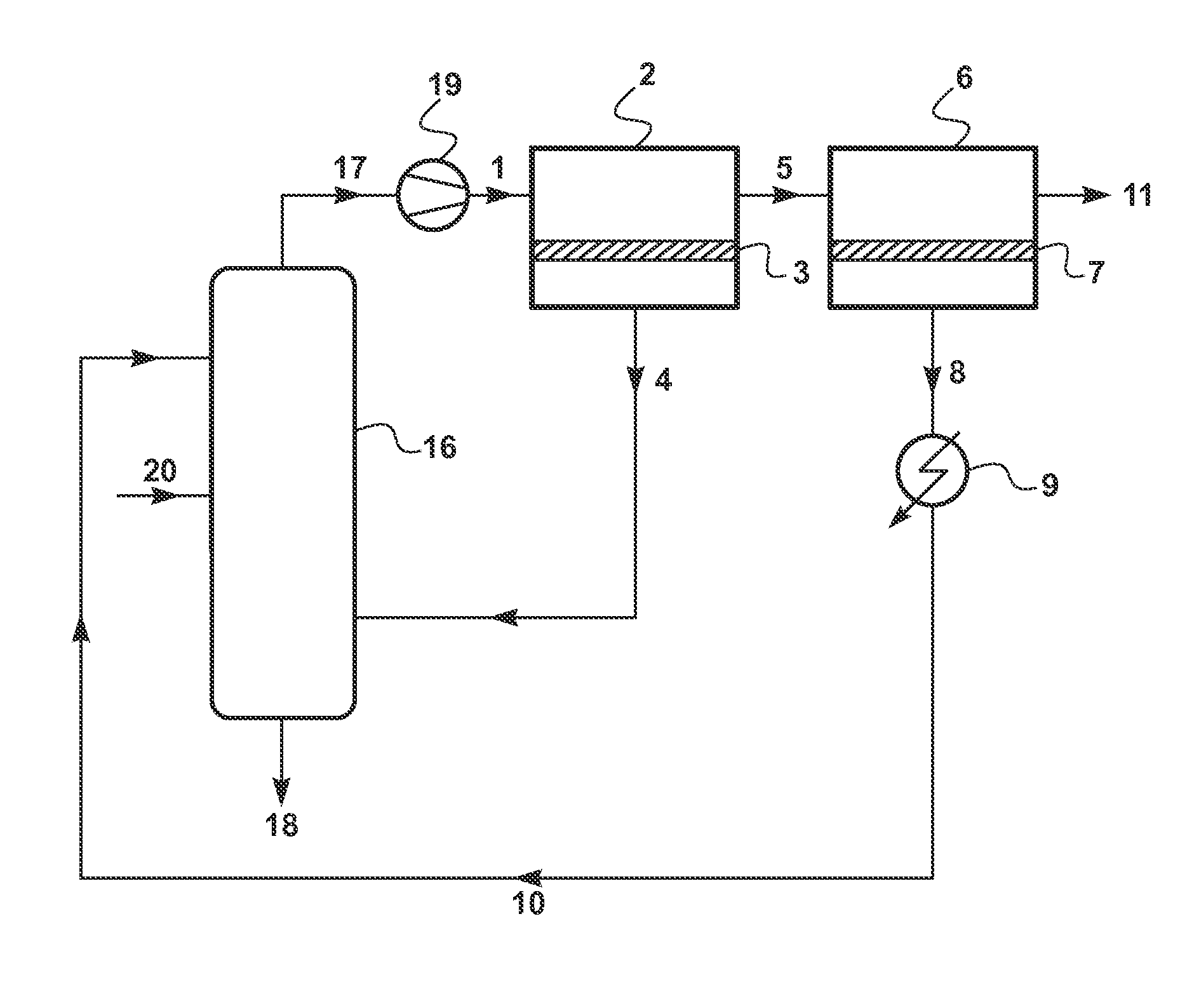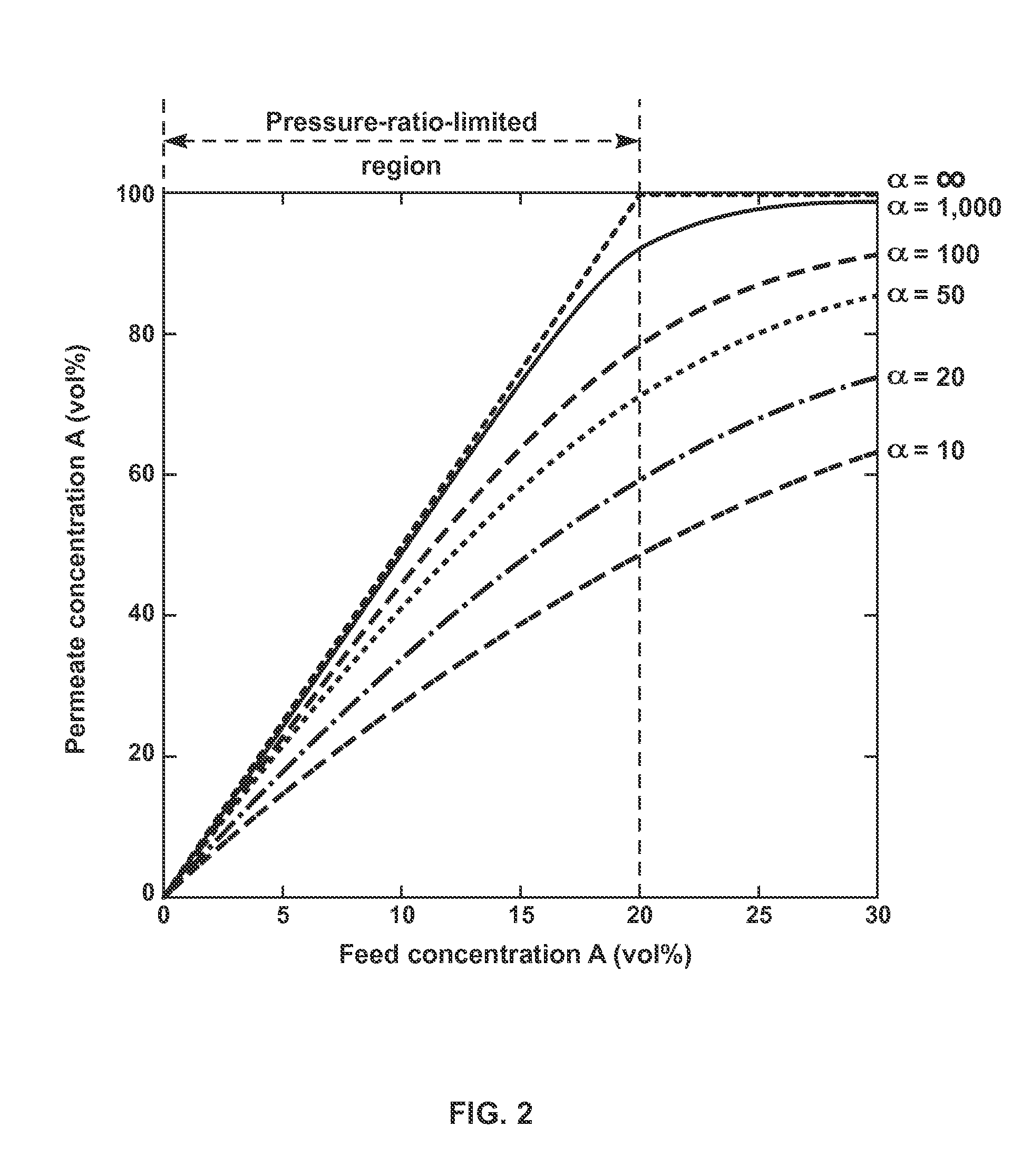Two-Step Membrane Gas Separation Process
a gas separation and membrane technology, applied in separation processes, membranes, dispersed particle separation, etc., can solve the problems of high permeability materials that exhibit low selectivity, operating costs tend to scale with driving force, and commercial gas separation processes are typically limited, so as to achieve low selectivity and save membrane area. large
- Summary
- Abstract
- Description
- Claims
- Application Information
AI Technical Summary
Benefits of technology
Problems solved by technology
Method used
Image
Examples
example 1
Determination of Component A Permeate Concentration Achievable for a Membrane Separation Step Operated at a Pressure Ratio of 30
[0122]A series of calculations was performed to determine the permeate concentration of a preferentially permeating component A that can be obtained from a gas mixture of component A with one or more other components B in a membrane separation step, under a given set of conditions. The following assumptions were made:
Pressure ratio: 30 (Feed side 3 bar, permeate side 0.1 bar)
Membrane permeance for component A: 1,000 gpu
Feed concentration of component A: variable
Membrane selectivity for A over B: variable.
[0123]The calculations were performed using differential element membrane code written at MTR and incorporated into a computer process simulation program (ChemCad 6.3, ChemStations, Austin, Tex.).
[0124]Based on expression (9), with a pressure ratio of 30, the limiting concentration of component A is 3.3 vol %. The results of the calculations for different f...
example 2
Determination of Component A Flux Achievable for a Membrane Separation Step Operated at a Pressure Ratio of 30
[0126]The calculations of Example 1 were repeated, using the same assumptions but this time plotting the flux of component A through the membranes under varying conditions of feed concentration and selectivity. The results are shown in FIG. 7.
[0127]At feed concentrations below the limiting value of 3.3 vol %, the separation is in the pressure-ratio-limited region and the component A fluxes are considerably affected by membrane selectivity. In this range, membranes with selectivity above 100 have low component A fluxes, which would necessitate the use of large membrane areas for that step.
[0128]Reviewing FIGS. 6 and 7 together, in the pressure-ratio-limited region, the modestly higher enrichment obtained with high selectivity membranes must be traded against the increased cost for a greater membrane area. In this range, membranes with lower selectivities, such as between 20 a...
example 3
Two-Step Process not in Accordance with the Invention, Using Membranes of Like Higher Selectivity
[0130]A calculation was performed to model the performance of the two-step membrane separation process of FIG. 8. This process is not in accordance with the invention, because there is no recycle of the second permeate stream, 31, and because we assumed the use of membranes, 23, of the same selectivity of 200 for component A over component B in both membrane separation steps, 22 and 28.
[0131]Referring to FIG. 8, raw feed stream, 21, containing at least components A and B, passes into first membrane separation step, 22, flows across the feed side of membranes, 23, and is separated into component-A-enriched permeate stream, 24, and component-A-depleted residue stream, 27. A low pressure is maintained on the permeate side of membranes 23 by cooling stream 24 by heat exchange or the like in cooling step, 25 to produce condensed permeate stream, 26.
[0132]Stream 27 passes as feed to second mem...
PUM
 Login to View More
Login to View More Abstract
Description
Claims
Application Information
 Login to View More
Login to View More - R&D
- Intellectual Property
- Life Sciences
- Materials
- Tech Scout
- Unparalleled Data Quality
- Higher Quality Content
- 60% Fewer Hallucinations
Browse by: Latest US Patents, China's latest patents, Technical Efficacy Thesaurus, Application Domain, Technology Topic, Popular Technical Reports.
© 2025 PatSnap. All rights reserved.Legal|Privacy policy|Modern Slavery Act Transparency Statement|Sitemap|About US| Contact US: help@patsnap.com



